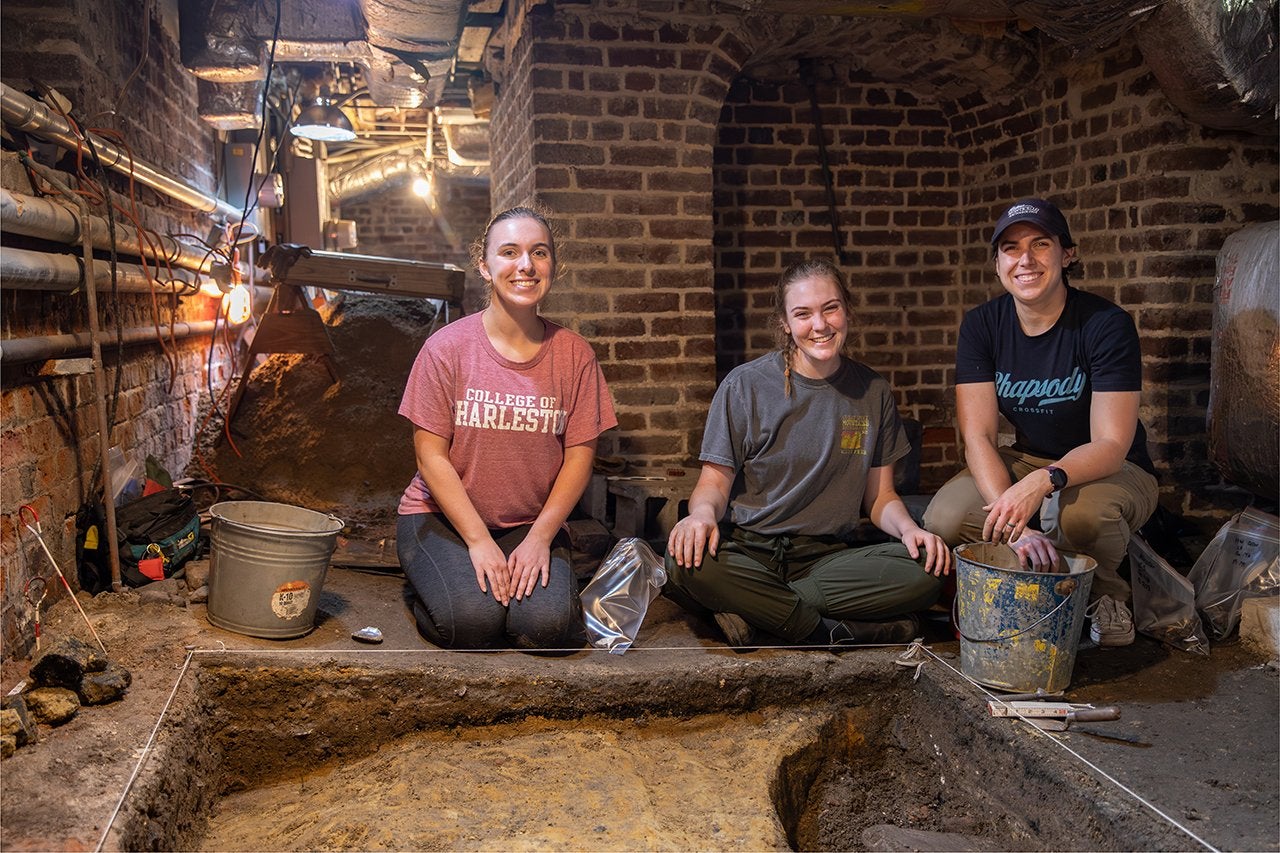With its abundant history, Charleston is the ideal place to study archaeology, and the Heyward-Washington House is one of the many Lowcountry sites worth exploring.
Recently, College of Charleston students got to dig into that history firsthand, assisting Sarah Platt, assistant professor of anthropology at the College, and Martha Zierden, curator of historical archaeology at the Charleston Museum, on an exploratory excavation in the cellar of the Heyward-Washington House. The group was looking for evidence of the previous residences located on the property before the house was built in 1772 for Thomas Heyward Jr., one of four South Carolina signers of the Declaration of Independence. Before Heyward lived on the site, it was home to the Milner family and at least 11 people they enslaved.

Students assist professor Sarah Platt with excavating the cellar of the Heyward-Washington House. (Photos by Catie Cleveland)
“One of the most crucial parts of training to become an archaeologist is to work on as many different types of sites as possible, since every site is a bit different and the skillsets required to excavate them and successfully identify artifacts and archaeological features varies pretty widely,” says Platt. “Beyond the convenience of the entire city being on the College’s doorstep for student experiences, urban Charleston is one of the most archaeologically and historically rich cities on the eastern seaboard because so much of its earliest history is preserved both above and below ground.”
Rising senior Jared Schiele, a double-major in classics and archaeology, had never been on a dig before, so he jumped at the chance to be a part of Platt’s team excavating the cellar of the Heyward-Washington House.
“It was awesome to get a nice and easy introduction to the basics of digging and archaeology,” he says. “I appreciated the opportunity to implement the theories we learned in class. To actually get into the dirt and see the different layers of earth and learn how to draw them on paper was really neat.”
While Schiele says he didn’t personally find any evidence at the site, he now feels confident to go on other excavations. “I’m planning on going to Greece to participate in a field school this summer, so this was a great introduction,” says the recipient of the Johnson-Vest Scholarship, The Samuel Freeman Trust – International Travel Scholarship and the Harold A. Mouzon Scholarship in Classical Studies.
“While we didn’t find what we were looking for this go-around, we did find a lot of evidence of how the cellar was used after the house was built, which until now was not well understood, such as butchered animal bone (likely the remnants of meals), evidence of a coal pile, and a lot of toys, such as marbles and jacks, suggesting kids were using the space to play,” says Platt. “We can use these little bits and pieces of everyday life to build a story about the people who lived at the site through time.”
“One of the most fulfilling moments of working at the Heyward-Washington House alongside Martha Zierden and Dr. Sarah Platt was just being able to identify what I was digging up,” says Sarah Byrd ’23, who graduated earlier this month with a degree in anthropology. “I could identify things that I couldn’t before on a previous dig I had done. Finally, I’ll say that digging in the dirt is just fun and it will always be fun. So, when Dr. Platt asked me to dig in the dirt with her, I couldn’t say no!”
Platt hopes that she will be able to plan more excavations of the cellar with students in the future.
“Heyward-Washington is an especially robust case study in Charleston history,” says Platt. “And more importantly, it gave the students the opportunity to learn directly from Martha Zierden, the leader in Charleston and Lowcountry archaeology and one of the founders of the field of urban historical archaeology in the United States.”




